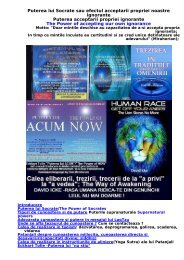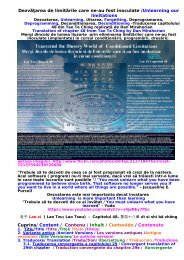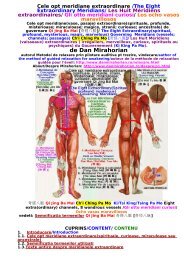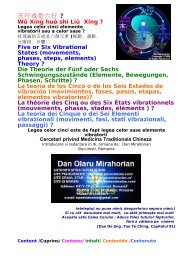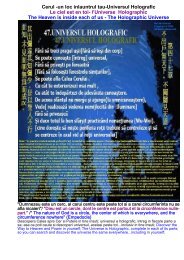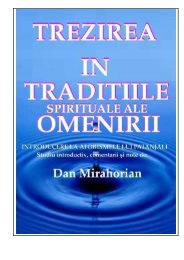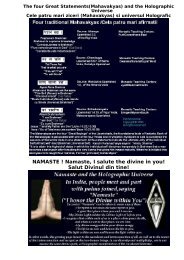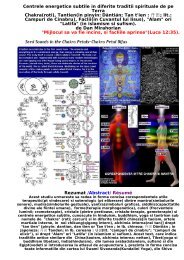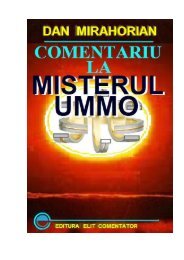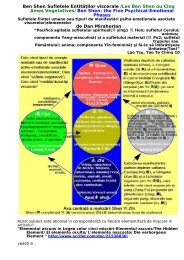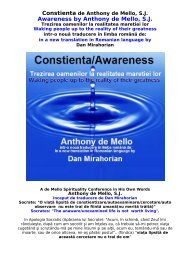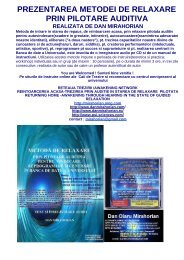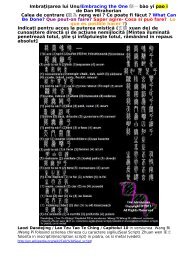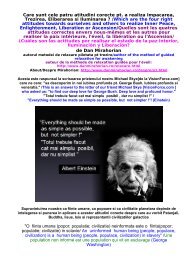Udana Vayu: localizare :gat si cap; centru ... - Dan Mirahorian
Udana Vayu: localizare :gat si cap; centru ... - Dan Mirahorian
Udana Vayu: localizare :gat si cap; centru ... - Dan Mirahorian
Create successful ePaper yourself
Turn your PDF publications into a flip-book with our unique Google optimized e-Paper software.
In the 1970s, in order to verify N.A.Kozyrev's theory, a major research of gyroscopes<br />
and gyroscopic systems was conducted by a member of Belarus Academy of Sciences,<br />
professor A.I.Veinik. The effect discovered earlier by N.A.Kozyrev was completely<br />
confirmed, but in order to explain the observed results, A.I.Veinik developed his own<br />
theory. According to this theory, every substance has it's own "chronal charge" defined<br />
by the quantity of "chronal" particles which were named "chronons". A.I.Veinik<br />
supposed that while the object is spinning, "chronons" are interacting with other<br />
"chronons" that surround this object and therefor the weight of the object changes.<br />
According to A.I.Veinik's theory, "chronons" generate the so called "chronal" field.<br />
A.I.Veinik found experimentally that strong "chronal" fields can be generated by<br />
spinning masses. A.I.Veinik measured some properties of "chronal" fields and found<br />
that two types of "chronons" exist ("plus" and "minus" chronons). It is important to<br />
empha<strong>si</strong>ze that A.I.Veinik concluded that the <strong>si</strong>gn of the "chronon" depended on<br />
orientation of it's spin [4].<br />
Reported observations of gyroscope weight variations have been made repeatedly by<br />
various researchers in many countries (e.g.[5-7]). Almost in all cases the observed<br />
effects were interpreted as the manifestation of antigravitation. In 1989, H.Hayasaka<br />
and S.Takeuchi conducted a series of experiments in which the fall-time of a freelyfalling<br />
spinning gyroscope was measured. They found that the fall-time varied<br />
depending on the angular velocity and the direction of rotation. H.Hayasaka and<br />
S.Takeuchi have attempted to explain the effect of antigravitation as the manifestation<br />
of tor<strong>si</strong>on fields generated by the spinning gyroscope [6].<br />
It should be noted that reports stating that the weight of a spinning gyroscope does<br />
not change are also known. Analy<strong>si</strong>s of these reports shows that experimenters have<br />
<strong>si</strong>mply not fulfilled the conditions required to achieve the expected effect.<br />
N.A.Kozyrev, A.I.Veinik and other researchers who obsered the change of weight<br />
empha<strong>si</strong>zed repeatedly that the rotation must be non-stationary. For instance,<br />
N.A.Kozyrev and A.I.Veinik used special vibrations, and H.Hayasaka experimented with<br />
moving (falling) gyroscopes.<br />
From the mid-50s to the late 70s, professor N.A.Kozyrev (with V.V.Nasonov) conducted<br />
astronomical observations u<strong>si</strong>ng a receiving system of a new type. When the telescope<br />
was directed at a certain star, the detector (de<strong>si</strong>gned by N.A.Kozyrev and<br />
V.V.Nasonov) po<strong>si</strong>tioned within the telescope registered the incoming <strong>si</strong>gnal even if<br />
the main mirror of the telescope was shielded by metal screens. This fact indicated<br />
that electromagnetic waves (light) had some component that could not be shielded by<br />
metal screens. When the telescope was directed not at the vi<strong>si</strong>ble but at the true<br />
po<strong>si</strong>tion of a star, the detector then registered an incoming <strong>si</strong>gnal that was much<br />
stronger. The registration of the true po<strong>si</strong>tions of different stars could be interpreted<br />
only as registration of star radiation that had velocities billions of times greater than<br />
the speed of light. N.A.Kozyrev also found that the detector registered an incoming<br />
<strong>si</strong>gnal when the telescope was directed at a po<strong>si</strong>tion symmetrical to the vi<strong>si</strong>ble<br />
po<strong>si</strong>tion of a star relative to it's true po<strong>si</strong>tion. This fact was interpreted as a detection<br />
of the future po<strong>si</strong>tions of stars [8].<br />
In the late 1980s to early 90s, astronomical observations u<strong>si</strong>ng the Kozyrev-type<br />
detector were successfully conducted by a group of academics at the Rus<strong>si</strong>an<br />
Academy of Sciences under M.M.Lavrentiev. While the sky was scanned by the<br />
shielded telescope with the detector in<strong>si</strong>de, it registered <strong>si</strong>gnals coming from the<br />
vi<strong>si</strong>ble po<strong>si</strong>tion of each star, the true po<strong>si</strong>tion, and also the po<strong>si</strong>tion symmetrical to the<br />
vi<strong>si</strong>ble po<strong>si</strong>tion of a star relative to it's true po<strong>si</strong>tion. M.M.Lavrentiev could not give a<br />
theoretical interpretation to these facts [9-11]. In 1992 these experiments were<br />
successfully repeated by the group of A.E.Akimov at the Main astronomical<br />
observatory of the Ukraine Academy of Sciences (Kiev,) and at the Crimean<br />
astrophy<strong>si</strong>cal observatory (Nauchnyi). The obtained results were interpreted as<br />
registration of tor<strong>si</strong>on waves. (As is well known, stars are objects with large angular<br />
momentum.) [12,13].<br />
In the course of the latter 50 years there have been numerous reports on anomalous<br />
behaviour of spin-polarized particles. In the USSR the groups under V.G.Baryshevsky



